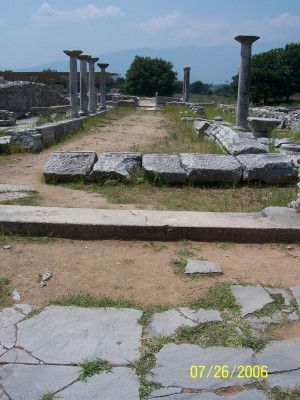|
The content on this website is maintained by
Robert Myallis, pastor at Zion's Lutheran Church, of Jonestown, PA.
The photos were taken by
Emily Myallis, a diaconal minister in the ELCA who also serves at Zion's Lutheran.
This website and travel to
Greece was made possible by a grant from the
Fund for Theological Education,
which provides grants to assist the education and formation of
Christian leaders from numerous denominations.
Bible quotes are taken from the New
Revised Standard Version, unless cites otherwise.
The above photo of Greece comes from
NASA; The icon of Saint Paul comes from George Mitrevski's website. |
 |
|
Philippi
 Philippi
was a large city, reestablished as a Roman colony by Julius
Caesar himself. (The picture is of a narthex to an early church
built here). The inhabitants of the city acquired the rights of
Roman citizens. The city boasted an immense population of Roman
colonists and veteran soldiers. The population and economy were
strong, attracting people from all over the Greco-Roman world.
The city maintained a strongly Roman feel. Evidence of this
comes not only from secular sources but even the brief visit by
Paul there in the Book of Acts. Indeed, of all the Greek cities
cited on this website, Philippi is the only site to have a
temple to a Roman god (Silvanus; unfortunately, the temple is
part of the site fenced off, hence no picture) Philippi
was a large city, reestablished as a Roman colony by Julius
Caesar himself. (The picture is of a narthex to an early church
built here). The inhabitants of the city acquired the rights of
Roman citizens. The city boasted an immense population of Roman
colonists and veteran soldiers. The population and economy were
strong, attracting people from all over the Greco-Roman world.
The city maintained a strongly Roman feel. Evidence of this
comes not only from secular sources but even the brief visit by
Paul there in the Book of Acts. Indeed, of all the Greek cities
cited on this website, Philippi is the only site to have a
temple to a Roman god (Silvanus; unfortunately, the temple is
part of the site fenced off, hence no picture)
Philippi in Paul's Ministry:
Paul's visit to Philippi is recorded in Acts 16. One can
basically follow Paul's time in Philippi through the remains of
the city:
1) Introduction to Phillipi's Roman heritage
2) Place of Lydia's baptism
3) Agora where Paul was put on trial
4) Prison
5) Baptistry
6) Via Ignatia where Paul left town
Paul will also write at least one letter to the congregation at
Philippi. In addition to articulating his theology on death and
resurrection, Paul also comments on how our life in Christ
models Christ's life of ultimate sacrifice (the most helpful
item to explain this however is not in Philippi, however; see
Thessalonian Slave Relief). Paul also praises
the Philippians' generosity; they were probably Paul's biggest
financial supporters.
sources:
Hadjifoti, Litsa. Saint Paul His Life and Work. Koropi, Greece:
Micael Toubis Publication, 2004.
Meeks, Wayne. The Urban Environment of Pauline Christianity. New
Haven: Yale University Press, 1983. |
|



 Philippi
was a large city, reestablished as a Roman colony by Julius
Caesar himself. (The picture is of a narthex to an early church
built here). The inhabitants of the city acquired the rights of
Roman citizens. The city boasted an immense population of Roman
colonists and veteran soldiers. The population and economy were
strong, attracting people from all over the Greco-Roman world.
The city maintained a strongly Roman feel. Evidence of this
comes not only from secular sources but even the brief visit by
Paul there in the Book of Acts. Indeed, of all the Greek cities
cited on this website, Philippi is the only site to have a
temple to a Roman god (Silvanus; unfortunately, the temple is
part of the site fenced off, hence no picture)
Philippi
was a large city, reestablished as a Roman colony by Julius
Caesar himself. (The picture is of a narthex to an early church
built here). The inhabitants of the city acquired the rights of
Roman citizens. The city boasted an immense population of Roman
colonists and veteran soldiers. The population and economy were
strong, attracting people from all over the Greco-Roman world.
The city maintained a strongly Roman feel. Evidence of this
comes not only from secular sources but even the brief visit by
Paul there in the Book of Acts. Indeed, of all the Greek cities
cited on this website, Philippi is the only site to have a
temple to a Roman god (Silvanus; unfortunately, the temple is
part of the site fenced off, hence no picture)